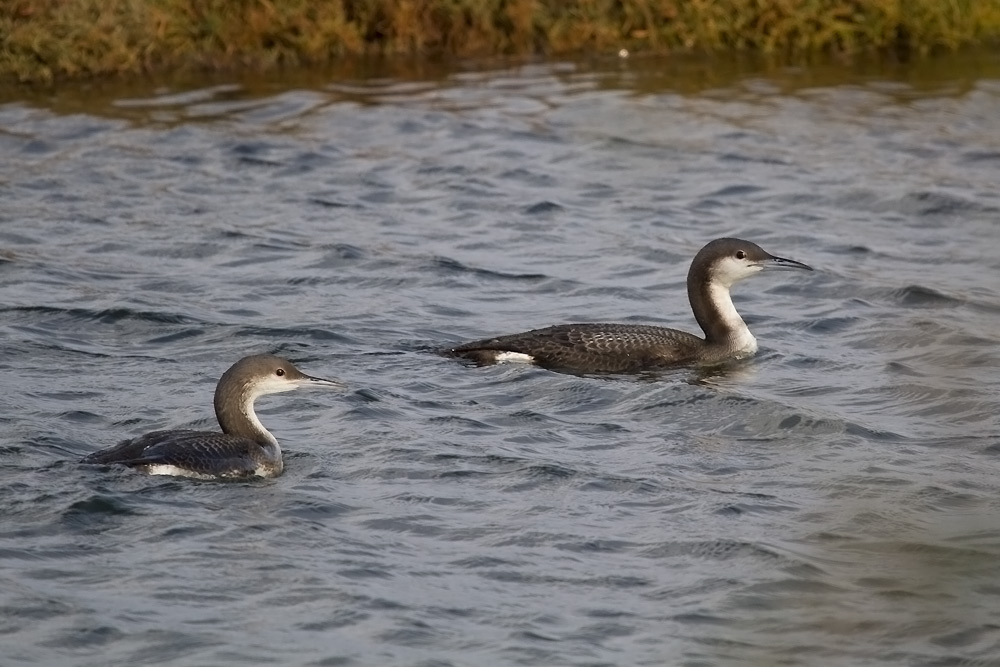Arctic loon
(Gavia arctica)

Description
The black-throated loon (Gavia arctica),also known as the Arctic loon and the black-throated diver,is a migratory aquatic bird found in the northern hemisphere,primarily breeding in freshwater lakes in northern Europe and Asia.It winters along sheltered,ice-free coasts of the north-east Atlantic Ocean and the eastern and western Pacific Ocean.This loon was first described by Carl Linnaeus in 1758.It has two subspecies.It was previously considered to be the same species as the Pacific loon,of which it is traditionally considered to be a sister species,although this is debated.In a study that used mitochondrial and nuclear intron DNA,the black-throated loon was found to be sister to a clade consisting of the Pacific loon and two sister species,the common loon and the yellow-billed loon.The black-throated loon measures about 70 cm (28 in) in length and can weigh anywhere from 1.3 to 3.4 kilograms (2.9 to 7.5 lb).In breeding plumage,the adult of the nominate subspecies has mostly black upperparts,with the exception of some of the mantle and scapulars,which have white squares.The head and hindneck are grey,and the sides white and striped black.Most of the throat is also black,giving this bird the name "black-throated loon".The colour of the throat patch can be used to distinguish the two subspecies;the throat patch of the other subspecies,G.a.viridigularis,is green.The underparts are mostly white,including the bottom of the throat.The flanks are also white,a feature which can be used to separate this bird from the Pacific loon.When it is not breeding,the black patch on the throat is absent,replaced with white;most of the black lines on the throat are also missing,except those on the bottom sides,and the upperparts are unpatterned with the exception of a few white spots on the upperwing.The juvenile is similar to the non-breeding adult,except more brown overall.The adult black-throated loon is 58 to 73 cm (23 to 29 in) in length with a 100 to 130 cm (39 to 51 in) wingspan and a weight of 1.3 to 3.4 kilograms (2.9 to 7.5 lb).The nominate subspecies in its breeding plumage has a grey head and hindneck,with a black throat and a large black patch on the foreneck,both of which have a soft purple gloss.The lower throat has a necklace-shaped patch of short parallel white lines.The sides of the throat have about five long parallel white lines that start at the side of the patch on the lower throat and run down to the chest,which also has a pattern of parallel white and black lines.The rest of the underparts,including the centre of the chest,are pure white.The upperparts are blackish down to the base of the wing,where there are a few rows of high contrast white squares that cover the mantle and scapulars.There are small white spots on both the lesser and median coverts.The rest of the upperwing is a blackish colour.The underwing is paler than the upperwing,and the underwing coverts are white.The tail is blackish.The bill and legs are black,with a pale grey colour on the inner half of the legs.The toes and the webs are grey,the latter also being flesh coloured.The irides are a deep brown-red.The sexes are alike,and the subspecies viridigularis is very similar to the nominate except that the former has a green throat patch,instead of black.The subspecies viridigularis does still retain a purplish gloss,although it is less than the nominate.The non-breeding adult differs from the breeding adult in that the cap and the back of the neck are more brownish.The non-breeding adult also lacks the patterned upperparts of the breeding adult,although some of the upperwing coverts do not lose their white spots.This results in the upperparts being an almost unpatterned black from above.The sides of the throat are usually darker at the white border separating the sides of the throat and the front of the throat;most of the time a thin dark necklace between these two areas can be seen.There is white on the sides of the head that are below the eye.The bill is a steel-grey with,similar to the breeding adult,a blackish tip.
Taxonomic tree:







